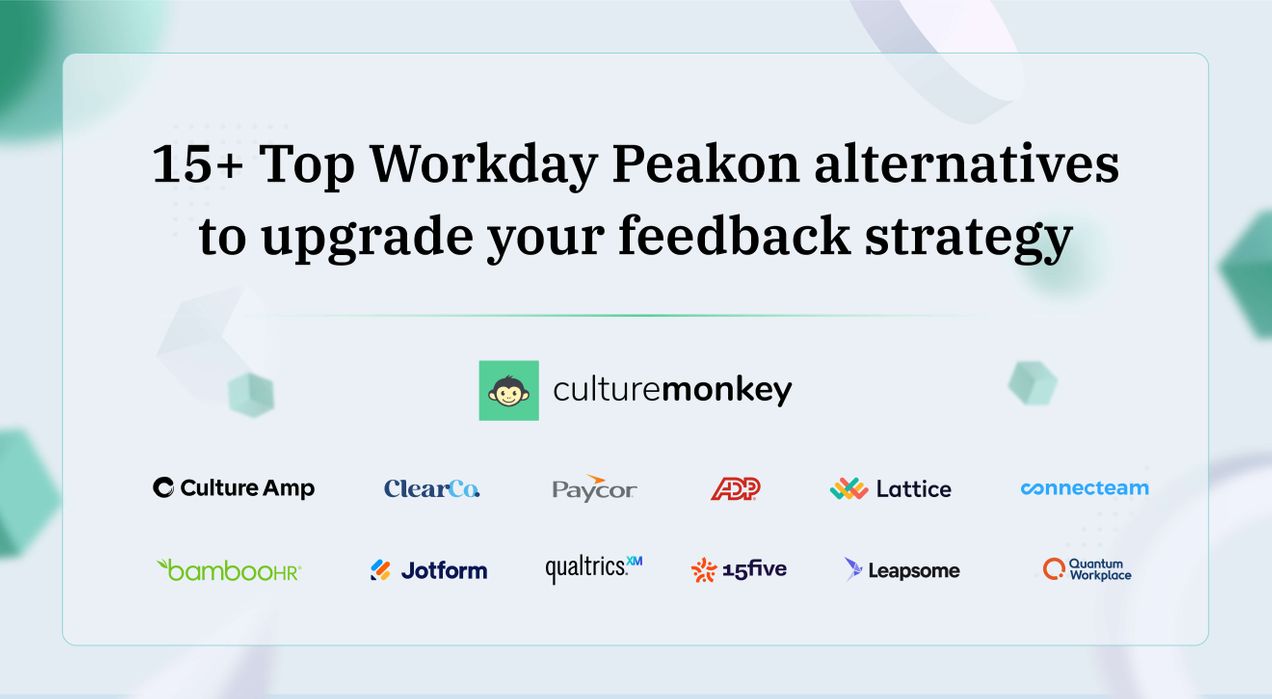Enterprise employee survey benchmarks: A complete guide for leaders in 2025

Think of a blueprint for constructing a skyscraper; it doesn’t tell you how tall the building will be today, but it sets the framework, measurements, and standards that ensure every floor is aligned for long-term stability.
Employee survey benchmarks serve the same purpose for enterprise leaders. They provide a reference point to compare your engagement results against industry norms, helping you see whether you’re building a thriving culture on solid ground or leaving cracks to grow unnoticed.
Understanding these benchmarks isn’t just a HR best practice; it’s a strategic necessity for creating workplaces that attract, retain, and empower top talent.
TL;DR
What are enterprise employee‑survey benchmarks?

TL;DR
Benchmarks contextualize engagement scores like favorability, eNPS, and engagement index against peers or historical data, highlighting strengths and gaps across units.
They cover leadership, manager effectiveness, and communication, enabling large enterprises to prioritize initiatives, track improvements, and turn survey results into actionable strategies that drive meaningful employee engagement outcomes.
Enterprise employee survey benchmarks serve as reference points that help large organisations evaluate their employee engagement survey results against relevant external standards.
Instead of interpreting employee engagement data in isolation, benchmarks give context, letting you compare your data to industry peers, regional averages, or even internal historical performance.
Let’s say your engagement index shows a 68% favorability rate. That might sound fine—until you realize your industry’s average sits at 74%, and top-performing companies are hitting 80%+.
That’s the value of benchmarks: they turn raw data into actionable insight on employee satisfaction by showing you where you stand, and where you could be.
For enterprises, this context becomes especially crucial. With 10,000+ employees across multiple geographies and business units, spotting patterns (and blind spots) isn’t easy.
Enterprise employee survey benchmarks cut through the noise by giving you clarity on your employee experience: are your scores typical for your size and sector, or are you lagging?
These benchmarks are usually derived from aggregated, anonymized data across many large organizations.
They cover a wide range of metrics, like the employee engagement index benchmark, favorability percentages, or the eNPS benchmark for large companies, including performance management, so you can zero in on specific areas like leadership trust, manager effectiveness, or communication.
How is benchmarking for enterprises different from benchmarking mid-sized companies?

While both enterprise and mid-sized companies use benchmarks to interpret engagement data, the scale, complexity, and strategic needs are vastly different. Enterprises require more nuanced benchmarking frameworks to avoid misleading comparisons and ensure honest feedback. Here’s how the two differ:
| Aspect | Enterprises | Mid-sized companies |
|---|---|---|
| Scale of data | Massive datasets from 10K+ employees, often across geographies. | Fewer data points, typically within one country or region. |
| Organizational complexity | Multiple departments, layers, and roles influence survey design and analysis. | Leaner structures make patterns easier to spot. |
| Benchmarking sources | Rely on broader, industry-specific enterprise engagement benchmarks. | Often benchmark against local or regional peers. |
| Customization needs | Require segmented benchmarks by region, function, and seniority level. | More standardized benchmarking suffices. |
| eNPS comparison | Use a specialized eNPS benchmark for large companies to stay competitive. | General eNPS benchmarks usually suffice. |
| Cadence & frequency | Often benchmark annually or quarterly across business units. | Typically benchmark annually. |
| Action planning complexity | Requires layered, function-specific initiatives post-benchmarking. | Simpler follow-up actions with centralized ownership. |
Common engagement benchmarking complexities faced by enterprise leaders

TL;DR
Enterprises face challenges like massive multi-regional data, cultural differences, low participation, and fragmented tools.
Even with insights, translating them into action requires aligning leadership, addressing underperforming pockets, and integrating legacy systems. Structured coordination ensures benchmarks guide targeted initiatives, improve engagement, and deliver measurable results across diverse departments and geographies.
For enterprise leaders, benchmarking employee engagement isn’t just about plugging numbers into a dashboard—it’s about making sense of them across massive, often messy, organizational ecosystems.
While benchmarks promise clarity through employee feedback, they also come with challenges that mid-sized setups rarely encounter. Here are six complexities leaders at scale often face:
1. Data overload without direction
With thousands of responses pouring in from multiple departments and regions, leaders often face analysis paralysis. It becomes tough to sift through the noise and focus on identifying which areas truly need attention versus those that are statistical anomalies.
2. One-size benchmarks don’t fit all
Enterprise engagement benchmarks are helpful, but applying them uniformly across a global workforce can backfire. What’s considered a strong engagement score in the U.S., according to Culture Amp, may be mediocre in Japan or too low in Germany, due to cultural and operational differences.
3. Misaligned benchmark relevance
Sometimes, enterprise teams benchmark themselves against industries or peer groups that aren’t a true match. Without precise alignment, based on size, region, and sector, especially for just a handful of industries, the comparisons become skewed and misleading.
4. Inconsistent participation rates
Departments or geographies with low survey participation can throw off benchmarking accuracy. A few underperforming pockets might disproportionately affect employee morale and the enterprise-wide employee engagement index benchmark.
5. Legacy tools and fragmented data
Large enterprises often use different HR tools across business units. Without integration, leaders may struggle to compile and benchmark data on engagement data cohesively and in a timely manner.
6. Translating benchmarks into action
Even when benchmarks reveal clear gaps, like a lagging eNPS benchmark for large companies, turning that insight into enterprise-wide action is no small feat. Aligning leadership across regions and business units can take months, slowing impact and ROI.
Score types explained: Favourability %, eNPS, engagement index

When interpreting enterprise employee survey benchmarks, it's crucial to understand the scoring formats behind the data. Each score type offers a different lens into employee sentiment, some zoomed in, some holistic. Let’s break down the three most widely used formats:
1. Favourability %
Favourability refers to the percentage of employees who respond positively (typically “agree” or “strongly agree”) to survey questions. It’s the most common format used in large-scale enterprise surveys because it highlights broad trends in alignment with industry standard practices.
For example, if 74% of employees rate their manager positively, that becomes the favorability score. It’s great for tracking individual question-level sentiment across time.
2. eNPS (employee net promoter score)
The eNPS benchmark for large companies helps measure loyalty and advocacy. Employees are asked how likely they are to recommend the organization as a place to work, rated on a scale of 0–10.
Promoters (9–10) and detractors (0–6) are calculated, and the final eNPS is derived by subtracting detractors from promoters. A high eNPS signals strong engagement, but leveraging AI can enhance interpreting this at an enterprise level and provide context by industry and region.
3. Engagement index
The employee engagement index benchmark is a composite score averaging responses from 4–6 key engagement questions. These often cover pride, commitment, discretionary effort, and intent to stay.
The index gives a rounded view of workforce engagement and is essential for benchmarking trends over time or comparing divisions. Many enterprises treat this index as their headline engagement KPI.
Good, great & world‑class targets for large enterprises

Not all engagement scores are created equal, especially at enterprise scale. When working with 10K+ employees, it’s helpful to categorize your results into clear target zones: Good, Great, and World-Class. These categories bring structure to workplace culture benchmarking while fostering ongoing dialogue and making goal-setting more strategic.
Good
A “Good” score typically means you’re in line with the enterprise engagement benchmarks for your industry and region. For example, a favorability score around 65–70% or an eNPS of +10 to +20 is common in many large companies. It shows your organization is stable, but there’s room to push beyond the average.
Great
Hitting “Great” suggests you're outperforming a significant portion of your peer group. Think 75–79% favorability or an eNPS between +30 to +40.
These scores indicate that your workforce is generally engaged, with fewer pockets of dissatisfaction. In most industry employee engagement statistics, this tier reflects companies that understand employee needs with strong internal alignment and consistent manager effectiveness.
World-Class
“World-Class” benchmarks are rarefied territory—typically achieved by top-quartile enterprises globally. This means 80%+ favorability, eNPS scores above +50, and a high-performing employee engagement index benchmark.
Organizations in this range are often cited as case studies and trendsetters, setting the standard for others to follow. Achieving this isn’t easy, but it’s the gold standard for large enterprises aiming for excellence.
Sampling & cadence for 10 K+ employees
TL;DR
Strategic sampling of representative employee groups reduces survey fatigue while maintaining valid benchmarks. Rotating populations ensures fresh insights without overwhelming teams.
Annual surveys anchor engagement, supplemented with quarterly or biannual pulses. Tailoring frequency by region or function improves participation, trust, and reliability, keeping enterprise benchmarks actionable, accurate, and meaningful across all workforce segments.
When you're surveying over 10,000 employees, sending the same questionnaire to everyone at once might feel like the most direct approach, but it’s not always the smartest.
Large enterprises benefit from strategic sampling and thoughtful cadence to ensure data quality without overwhelming teams or systems.
Sampling involves selecting representative employee groups that reflect your larger workforce by geography, department, function, or tenure.
Rather than surveying all 10K+ employees every time, many enterprises rotate survey populations, ensuring fresh insights while minimizing survey fatigue. When structured right, samples as small as 20-30% can still deliver statistically valid enterprise employee survey benchmarks.
While cadence is all about timing. Most large organizations run an annual engagement survey as their anchor, but that alone isn’t enough.
Supplementing it with quarterly or biannual pulse checks ensures leaders can track progress and benchmark shifts in real-time. Especially when tracking enterprise engagement benchmarks or an eNPS benchmark for large companies, fostering trust with employees ensures consistency in timing, making year-over-year comparisons meaningful.
Another key factor: tailoring cadence by region or business unit. Some functions may prefer more frequent touchpoints, while others respond better to a once-a-year deep dive.
Either way, a flexible and well-planned cadence keeps your data actionable and your employee engagement index benchmark reliable without causing survey fatigue or burnout.
Benchmark‑to‑action workflow (Data → Insight → ROI)
TL;DR
Segmented engagement data compared to peers identifies gaps and patterns. Contextualized metrics like eNPS or favorability % generate actionable insights. Targeted initiatives—leadership training, feedback loops, or mobility programs—drive improvement.
Measuring ROI through retention, performance, or satisfaction ensures enterprise survey data translates into tangible outcomes that enhance culture, engagement, and productivity.
Gathering data is just step one. The real impact of enterprise employee survey benchmarks lies in what you do with that information. The journey from raw survey results to measurable ROI follows a structured path: Data → Insight → Action → ROI.
1. Data collection
Start with robust data—favourability %, the employee engagement index benchmark, and the eNPS benchmark for large companies. For enterprises, this means thousands of responses segmented by region, department, or level. Ensure consistency in questions and cadence to maintain benchmark accuracy over time.
2. Generate insight
Data without context is just noise. Benchmarking transforms raw numbers into meaningful insights by comparing your results against enterprise engagement benchmarks or industry employee engagement statistics. This is where patterns emerge—low scores in measuring employee engagement, like manager communication or regional dips in engagement, can now be seen in contrast to similar companies.
3. Translate to action
Insight alone won’t move the needle. Enterprise leaders must turn those insights into targeted, team-specific actions, like leadership training, feedback loops, or internal mobility programs. Action planning should be tailored based on areas of improvement highlighted by benchmark gaps.
4. Measure ROI
Once initiatives are in place, tie outcomes, like retention, performance, or satisfaction, back to the original data. Enterprises that outperform on best-in-class engagement score benchmarks often see returns through lower turnover, stronger culture, and improved productivity.
How does CultureMonkey help you benchmark enterprise survey data seamlessly?

TL;DR
CultureMonkey provides industry- and geography-specific benchmarks, real-time dashboards, granular segmentation, AI-driven action nudges, and seamless HR integrations.
Leaders can quickly contextualize engagement scores, turn insights into targeted initiatives, bridge the gap between analysis and execution, and maintain data accuracy, simplifying enterprise-scale benchmarking while driving measurable improvements in employee engagement.
Benchmarking at scale isn’t just about collecting numbers—it’s about interpreting them in a way that drives smart action. That’s where CultureMonkey steps in. It simplifies the complexity of enterprise employee survey benchmarks with features designed for large organizations.
- Industry-specific benchmark comparisons: CultureMonkey gives you access to enterprise engagement benchmarks tailored by industry and geography. This means your engagement index or eNPS isn’t just compared globally, but against peers who face similar challenges, helping you make sharper, more relevant decisions.
- Real-time analytics and dashboards: With CultureMonkey, there’s no waiting around for reports. Its live dashboards update in real-time, allowing HR leaders to immediately see how their scores, like favourability % or the employee engagement index benchmark, stack up against internal and external benchmarks.
- Granular segmentation at scale: Need to compare engagement in your R&D teams in Germany with sales teams in India? CultureMonkey’s segmentation filters make that possible. You can benchmark engagement across any department, function, or region, without losing sight of the bigger picture.
- Actionable insights with AI-powered nudges: Once you identify gaps, say in your eNPS benchmark for large companies, CultureMonkey nudges managers with personalized actions to close them. It bridges the common enterprise gap between insight and execution.
- Seamless integration with enterprise systems: CultureMonkey plugs into your existing HR tech stack, so you’re not stuck importing spreadsheets. It automates benchmarking workflows while preserving data integrity across platforms, making your engagement strategy leaner, faster, and more accurate.
Conclusion
Benchmarking isn’t just a checkbox in your engagement survey process; it’s the compass that helps enterprise leaders navigate massive amounts of data with clarity and purpose.
By understanding favourability scores, tracking the employee engagement index benchmark, and aligning with the right eNPS benchmark for large companies, you can move from guesswork to grounded decisions that include meaningful recognition. The challenge lies in doing all this at scale, while keeping the insights actionable and the outcomes measurable.
That’s where CultureMonkey helps you benchmark smarter, segment deeper, and act faster, so your engagement strategy isn’t just data-rich, but results-driven. If you’re ready to go beyond surface-level survey scores and unlock enterprise-level ROI, CultureMonkey is your trusted partner in the journey.
Summary
FAQs
1. What is the current global engagement rate for enterprises?
The current global engagement rate for enterprises typically ranges between 65% to 72% favourability, depending on industry and region. However, top-performing organizations often surpass 80%. These rates serve as key enterprise employee survey benchmarks, helping leaders understand how their workforce compares to global norms and identify areas where engagement can be improved strategically.
2. What’s a good eNPS for a large organization?
A good eNPS for a large organization falls between +30 and +40. This range indicates a healthy level of employee advocacy. However, world-class enterprises aim for +50 or higher. The eNPS benchmark for large companies is vital for tracking workforce sentiment at scale and aligning engagement strategies across diverse teams and business units.
3. How often should enterprises benchmark engagement?
Enterprises should benchmark engagement at least annually, with quarterly pulse surveys in between to track progress. Regular benchmarking ensures your engagement scores, like favourability or the employee engagement index benchmark, stay relevant and actionable regardless of company size. Frequent cadence also helps you adjust strategies quickly based on real-time trends across departments, regions, or the entire workforce.
4. Why compare by industry and region?
Comparing by industry and region ensures your engagement data isn’t being measured against irrelevant or misleading standards. Enterprise engagement benchmarks vary significantly across sectors and cultures. Aligning with relevant peer groups helps create accurate targets, uncover localized gaps, and craft more effective action plans that resonate with the specific needs of each business unit.
5. What ROI comes from beating top‑quartile benchmarks
Beating top-quartile benchmarks often translates to reduced turnover, higher productivity, and improved business performance. Enterprises with best-in-class engagement scores see stronger retention and faster innovation. Whether it’s outperforming the employee engagement index benchmark or improving eNPS, the ROI lies in increased loyalty, better customer outcomes, and stronger financial results across the board.



